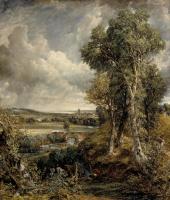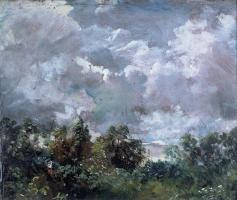John Constable
John Constable was born in Suffolk, the son of a mill-owner, farmer and merchant; and the scenes that surrounded him in his childhood are the ones he later made famous through his beautiful landscapes. He went to the Royal Academy Schools in his early twenties, but not until his forties did he achieve a measure of success. The Hay-Wain was shown at the Royal Academy in 1821, and in 1824 it was exhibited with two other Constable landscapes at the Paris Salon, where it was awarded a gold medal. The best-known paintings of the English landscape are those by John Constable, and of them all The Hay-Wain is the most famous.
Constable’s life was divided between London and Suffolk, but it is East Anglia, and Suffolk in particular, which to him was the heart of England. He has caught its character so superbly that his paintings of winding streams and rivers, flat water-meadows, brick farm buildings, and fast-moving clouds in a vast expanse of sky seem to sum up the spirit of the English landscape. He wrote of his love for ‘the sound of water escaping from mill dams… willows, old rotten banks, slimy posts & brickwork…’, and he said he would always ‘paint his own places best… Painting is but another word for feeling.’
 The Hay-Wain is one of a series of six large paintings (each about six feet
across) in which he expresses his feelings for landscape superbly. He completed
it in about five months, and would have made sketches of the subject on the
spot before starting work in oils in his London studio. The paint is applied
in short and long, rough and smooth strokes, making a rich variety of texture
Constable has picked out the characteristic elements of the landscape : light
glitters off moist leaves in shadowy places; water reflects the plants along
its banks and the light in the sky; and it is the sort of cloudy day, with
intermittent sunshine, which is typical of English weather.
The Hay-Wain is one of a series of six large paintings (each about six feet
across) in which he expresses his feelings for landscape superbly. He completed
it in about five months, and would have made sketches of the subject on the
spot before starting work in oils in his London studio. The paint is applied
in short and long, rough and smooth strokes, making a rich variety of texture
Constable has picked out the characteristic elements of the landscape : light
glitters off moist leaves in shadowy places; water reflects the plants along
its banks and the light in the sky; and it is the sort of cloudy day, with
intermittent sunshine, which is typical of English weather.
It is rich farming country, and there are signs everywhere of activity: in the distance are cattle and farm-workers, in the foreground a low fence borders a vegetable garden near the old tiled cottage, and the centre of it all is the wide shallow river. A man can be seen in the bushes on its far bank, with a rowing boat moored close by, and a group of ducks in mid-stream. By the Watergate outside the cottage a woman appears to be washing clothes or maybe collecting water in the large jug beside her. A farm dog trots along the near bank watching the two men as their horse-drawn wagon makes its way through the river. Little touches of red, often to be found in Constable landscapes, provide a focal point. It is a very peaceful scene, but Constable’s eye for detail has noted all the small features which might otherwise be overlooked. He draws attention to them with little pinpoints of light against the shadows, filling the composition with interest, and building up a picture which typifies nineteenth-century English rural life.
 The inhabited landscape was Constable’s constant and most intimate theme. The
lane to the cornfield is the same one the artist followed to school; this is
the Suffolk that he carried in his heart all his life. The Cornfield traces
several points in time and space. The vertical format steers the viewer’s
gaze, from the boy at the stream, to the man reaping the corn and finally, to
the church tower among the trees. The Romantic poet Wordsworth subscribed to
the fund that purchased this picture for the English National Gallery.
The inhabited landscape was Constable’s constant and most intimate theme. The
lane to the cornfield is the same one the artist followed to school; this is
the Suffolk that he carried in his heart all his life. The Cornfield traces
several points in time and space. The vertical format steers the viewer’s
gaze, from the boy at the stream, to the man reaping the corn and finally, to
the church tower among the trees. The Romantic poet Wordsworth subscribed to
the fund that purchased this picture for the English National Gallery.
 For Constable, ‘skying’ meant making small oil studies of clouds, with full
notes written on the back. Typically, he covered red primer in thick strokes
and overlapping colours, which gave depth to the cloud formation. They were not
necessarily part of any larger composition, but recorded the reality of
weather, light and colour in a particular patch of sky.
For Constable, ‘skying’ meant making small oil studies of clouds, with full
notes written on the back. Typically, he covered red primer in thick strokes
and overlapping colours, which gave depth to the cloud formation. They were not
necessarily part of any larger composition, but recorded the reality of
weather, light and colour in a particular patch of sky.





